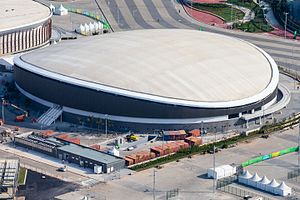Rio Olympic Velodrome

Aerial view of the Rio Olympic Velodrome
|
|
| Location | Barra da Tijuca, Rio de Janeiro, Brazil |
|---|---|
| Coordinates | 22°58′28.93″S 43°23′32.04″W / 22.9747028°S 43.3922333°WCoordinates: 22°58′28.93″S 43°23′32.04″W / 22.9747028°S 43.3922333°W |
| Capacity | 5,000 |
| Construction | |
| Opened | 25 July 2016 |
| Construction cost |
R$ 143.6 million (US$ 44.82 million) |
| Architect | Schuermann |
| Main contractors | Tecnosolo S.A (former) Engetécnica (current) |
The Rio Olympic Velodrome, officially the Velódromo Municipal do Rio (Rio Municipal Velodrome), is a velodrome located in the Barra Olympic Park sports complex in Rio de Janeiro, Brazil. Built as a replacement for the former Barra Velodrome, the venue hosted track cycling events during the 2016 Summer Olympics, and is scheduled to host track cycling events during the 2016 Summer Paralympics. After the conclusion of the games, the velodrome will form part of the Olympic Training Center.
The Rio Olympic Velodrome was designed by Schuermann Architects, a German design group led by Ralph Schuermann. The group had previously designed the Laoshan Velodrome for the 2008 Summer Olympics in Beijing, along with six other Olympic cycling venues and twenty World Championship venues. The wooden track is made from timber sourced from the Siberian pine, considered to be the fastest surface for track cycling.
The Barra Velodrome, one of three venues built as part of the City of Sports Complex in Barra da Tijuca for the 2007 Pan American Games, was originally planned to host cycling events for the 2016 Summer Olympics and Paralympics. The original plan for the expansion of the City of Sports Complex into the current-day Barra Olympic Park would have seen the Barra Velodrome receive minor upgrades to prepare it for the Olympics. However, in early 2013, the International Cycling Union (UCI), the governing body of sports cycling, deemed the velodrome as unsuitable for hosting Olympic events, citing pillars obscuring the view of spectators and judges, and cyclists' inability to reach significant speeds on the track. The cost of upgrading the venue to UCI standards was seen as equally as expensive as building a completely new venue, and thus it was decided that the Barra Velodrome was to be demolished in favour of building a new one at a different site in the park. After the Barra Velodrome was demolished, work on the Rio Olympic Velodrome began, with British firm 3D Reid, who designed the Commonwealth Arena and Sir Chris Hoy Velodrome for the 2014 Commonwealth Games, was chosen alongside Rio de Janeiro-based firm BLAC Architects to help advise design development of the Velodrome.Tenders to construct and operate the venue were opened in October 2013 and won by Brazilian engineering firm Tecnosolo S.A, at a budget of R$136.9 million. The cost did not include the budget for track installation, which was to be the responsibility of the Olympic Organizing Committee.
...
Wikipedia
